
The Trichiini are a tribe of the scarab beetle family (Scarabaeidae), though historically they were often classified as a subfamily, Trichiinae. In Europe, the conspicuous bee beetles (Trichius) are probably the best-known genus of the tribe.

Flower chafers are a group of scarab beetles comprising the subfamily Cetoniinae. Many species are diurnal and visit flowers for pollen and nectar, or to browse on the petals. Some species also feed on fruit. The group is also called fruit and flower chafers, flower beetles and flower scarabs. There are around 4,000 species, many of them still undescribed.

Rhabdotis aulica, known as the emerald fruit chafer, is a species of Scarabaeidae, the dung beetle family, and is found in Africa. Adult beetles, which are about 25 millimetres (0.98 in) long, feed on flowers and fruit, laying their eggs in goat and cattle manure. The pupae develop inside egg-shaped protective clay shells.

Eudicella gralli, sometimes called the flamboyant flower beetle or striped love beetle, is a brightly coloured member of the scarab beetle family, in the subfamily known as flower beetles. Their shells seem to have a prismatic quality, refracting the ambient light to give the green of their carapace a rainbow tint. This species of flower beetle lives in the rainforests of Africa, where it feeds on the nectar and pollen of flowers, but is popular in the exotic pet trade. The larvae of the flower beetle live in decaying wood, feeding on dead wood and leaf litter. Adults reach lengths of 25–40 millimetres (0.98–1.57 in). As in other species of this genus, the males have a Y-shaped horn, used to fight over females. The females have a shovel-like tusk, used for burrowing in wood. During their gestation period they will dig into the wood and lay eggs.
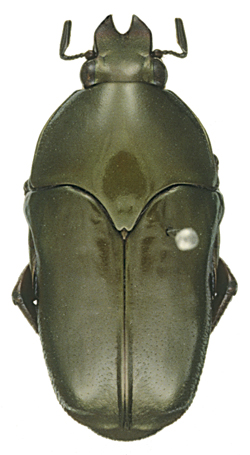
Ischiopsopha are beetles from the subfamily Cetoniinae, tribe Schizorhinini. The genus was created by Raffaello Gestro in 1874. The type species of the genus is Cetonia bifasciata Quoy & Gaimard, 1824. These cetoniids have only the tip of the scutellum visible. The genus is widespread throughout the whole Australian region.
Vincent Allard was a Belgian entomologist.

Pachnoda is a genus of beetles from the subfamily Cetoniinae with nearly all of the species living in Africa. The limit of the genus is given by the presence of internal lobes in their aedeagi.

Lomaptera are beetles from the subfamily Cetoniinae, tribe Schizorhinini. The genus was created by Gory & Percheron, in 1833. The type species of the genus is Cetonia papua Guérin-Méneville, 1830. These cetoniids have the tip of the scutellum invisible, which makes the difference with the genus Ischiopsopha.
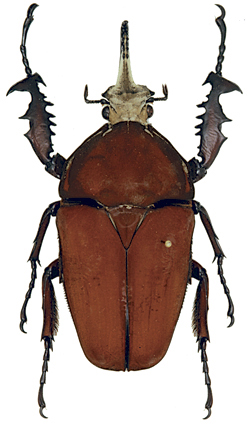
Mecynorhina are beetles from the subfamily Cetoniinae, tribe Goliathini. The genus was created by Frederick William Hope, in 1837.
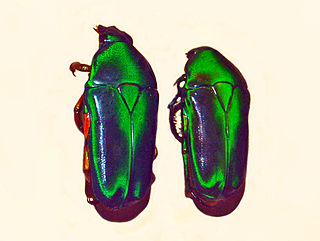
Tmesorrhina is a genus of beetles belonging to the family Scarabaeidae, subfamily Cetoniinae.

Rhabdotis albinigra is a species of Scarabaeidae, the dung beetle family. It was described by Hermann Burmeister in 1847.

Eudicella is a genus of small to medium beetles in the subfamily Cetoniinae, belonging to the wider family Scarabaeidae. They are distributed throughout the Afrotropical realm, including South Africa, Rwanda and Zimbabwe.
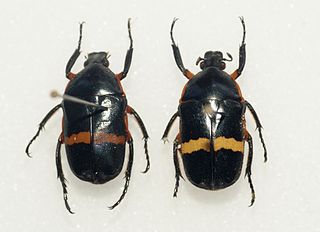
Chondrorrhina is a genus of fruit and flower chafers belonging to the family Scarabaeidae, subfamily Cetoniinae, found in Africa.
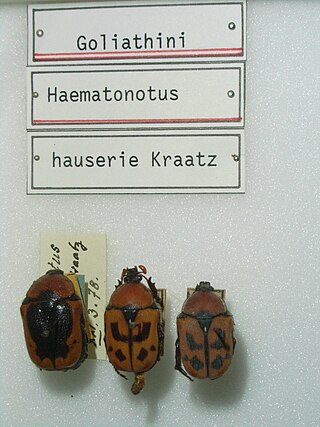
Rhinocoeta is a genus of colorful beetles belonging to the subfamily Cetoniinae, family Scarabaeidae.

Trichiotinus is a genus of fruit and flower chafers in the family Scarabaeidae. There are about 8 described species in Trichiotinus, all native to the New World.

Cetoniini is a tribe of fruit and flower chafers in the family of beetles known as Scarabaeidae. There are over 80 genera in Cetoniini, found worldwide.
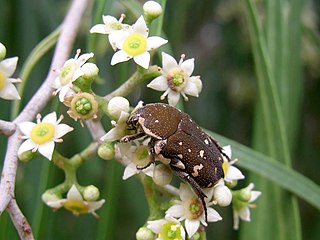
Glycyphana is a genus of beetles of the family Scarabaeidae.

Oryctini is a tribe of beetles in the Dynastinae.

Gametis is a genus of flower chafer in the family Scarabaeidae, with under 10 species found in Asia.
Pedinorrhina is a genus of fruit and flower chafers belonging to the family Scarabaeidae, subfamily Cetoniinae, found in Africa.


















